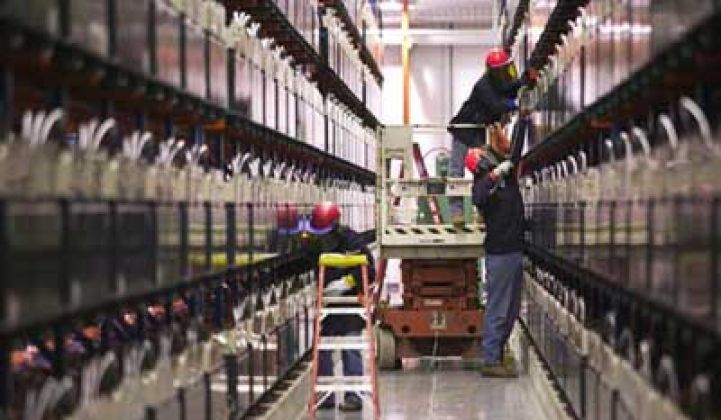Large grid-scale energy storage has moved from its demonstration and pilot program phase to its early commercialization phase. And commercialization for U.S. utilities comes in the form of requests for quotation (RFQ), and solicitations like the one just issued by the Imperial Irrigation District.
Last June, the PUC asked California's big three investor-owned utilities to procure 1.3 gigawatts of energy storage by 2020, along with setting market mechanisms to launch the procurement process.
The recent 50-megawatt Southern California Edison Los Angeles Basin Energy Storage RFQ reveals a California utility industry getting its head around deploying big energy storage. The SCE solicitation was notable for the effort taken to identify the true value of grid-scale energy storage. In the words of John Zahurancik, VP of Deployment and Operations at AES Energy Storage, "The Edison RFQ is the first formal recognition by a state that [energy storage] absolutely has value."
Zahurancik saw the SCE solicitation as a "way to get started" in enhancing "local capacity and local reliability." Praveen Kathpal, AES Energy Storage's VP of market and regulatory affairs, said that the RFQ is oriented toward local capacity requirements in the LA Basin -- a capacity alternative offering "where energy storage can perform the same functions as building a new peaking power plant." Zahurancik observed that California and SCE have structured the offer so that storage can be treated similarly to a preferred resource like demand response or energy efficiency.
And now Imperial Irrigation District (IID), a municipal utility that provides power and water services to about 150,000 residential, commercial, and industrial customers in the southeastern part of California's desert, just took a step toward deploying energy storage with the issuance of QR 123, the start of a solicitation for 20 megawatts to 40 megawatts of battery storage. IID is also the third-largest public power utility in the state and the nation’s largest irrigation district.
The utility wants "respondents to design, engineer, procure and construct a utility-scale energy storage project" and specifies that it is a "battery" storage project. That implies that flywheels, portable CAES and rail cars need not apply.
This solicitation is very broad in asking that the project "accommodate, at a minimum, the following operational characteristics:"
- Provide spin/non-spin reserves
- Provide automatic ramping
- Provide frequency regulation
- Provide capacity (20 MW to 40 MW)
- Support intermittent renewable integration
- Peak shift energy
- Provide black-start capability
- Provide ancillary service capacity
- Smooth intermittent resource output
- Improve short-duration performance
- Improve system reliability
- Improve power quality
- Integrate intermittent distributed generation
- Provide uninterruptible power supply
This shopping list of services is what a battery system might furnish in an ideal universe. The reality will look far different. No single energy storage system can provide all or even most of those requirements.
At this stage, the utility is simply looking at vendor qualifications and getting input from companies including A123 Systems, Black & Veatch Renewables, Borrego Solar Systems, Clairvoyant Energy, Coachella Energy Storage Partners, EnerVault, Prudent Energy, S&C Electric, Stem, Tenaska Solar Ventures and Xtreme Power. Responses are due February 11.
According to the solicitation, respondents should have experience in "generation projects, transmission grids, balancing authority area, and interconnected power systems" and an understanding of "power flow, voltage profile, line flow, transmission flow, transmission losses, generation patterns, renewable intermittency, regulation criteria, operating reserves criteria, NERC and Federal Energy Regulatory Commission (FERC) reliability requirements."
California is home to several large-scale energy storage projects funded by DOE grants. PG&E is building a 300-megawatt, ten-hour CAES system in the Central Valley, and SCE has been working with LG Chem on an 8-megawatt, 32-megawatt-hour lithium-ion battery warehouse in the Tehachapi mountain range. Both projects are aimed at stabilizing and integrating the state’s wind power resources into the grid.
****
GTM Research’s recent report, Grid-Scale Energy Storage in North America 2013: Applications, Technologies and Suppliers, pinpoints the most promising energy storage applications, geographic markets and market segments and profiles over 150 companies active in the North American storage industry, including 25 that are particularly well positioned to succeed. More details are available here.



